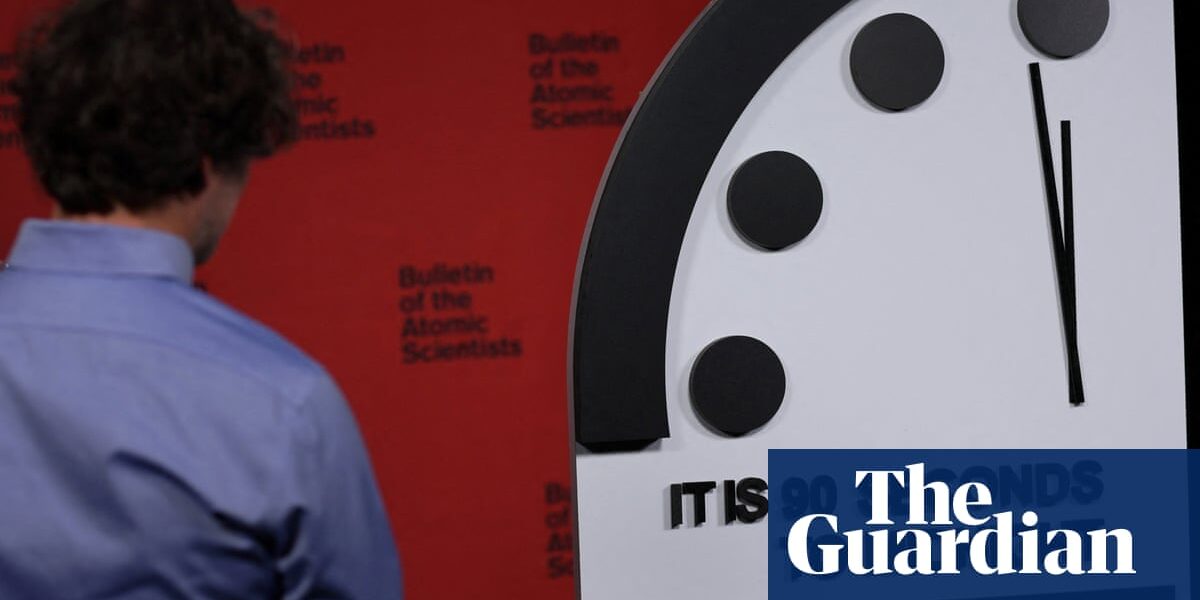The threat of war and the current state of the climate crisis have resulted in the Doomsday Clock remaining at 90 seconds to midnight.

According to a group of global scientists, the Doomsday Clock, which represents the time left until human annihilation, has remained at 90 seconds to midnight. This is the closest it has been since its creation in 1947.
The Atomic Scientists’ Bulletin mentioned the ongoing possibility of nuclear escalation in Ukraine, the “horrors of contemporary warfare” in Israel and Gaza, and the insufficient response to the climate emergency, which endangers “countless lives”.
“Ninety seconds to midnight is profoundly unsustainable,” said Rachel Bronson, the president and chief executive of the organisation.
In the previous year, the Bulletin of the Atomic Scientists placed the symbolic Doomsday Clock at 90 seconds before midnight, which was the closest it had been since its creation after World War II.
According to a group of global researchers, the survival of humanity is in more danger than ever before due to the Ukrainian invasion and Russia’s open indications of potentially using nuclear arms.
The Bulletin was established in 1945 by Albert Einstein and his colleagues, who were involved in the creation of the first atomic weapons. Its goal is to inform the public about potential catastrophic threats to the world.
The Bulletin annually revises the symbolic Doomsday Clock to demonstrate potential man-made dangers on a global scale, such as nuclear warfare, biothreats like Covid-19, advancements in artificial intelligence, and the climate crisis. The clock striking midnight signifies the possible end of the world.
Each year, the time on the clock is adjusted by the science and security board of the Bulletin, with the backing of its board of sponsors, consisting of 10 Nobel Prize winners.
In its announcement for 2024, the Bulletin stated that numerous global dangers played a role in their choice, including the conflict between Russia and Ukraine and the weakening of agreements for nuclear arms reduction. Additionally, the Bulletin cited the climate emergency and the fact that 2023 was declared the hottest year on record, as well as the advancements in genetic engineering technology and the rapid progress of generative AI. These factors have the potential to amplify disinformation and disrupt the global information landscape, making it more difficult to address pressing existential issues.
The Bulletin has faced backlash for employing fear-mongering tactics by steadily advancing the clock towards midnight over the years.
Prior to 2017, the clock solely utilized full minutes and was set at two and a half minutes to midnight. However, in 2020 it began incorporating seconds and is currently set at 100 seconds to midnight.
The Bulletin has stated that it is not politically motivated and has adjusted the clock hand to move away from midnight just as frequently as it has moved towards it in response to criticism.
In the most recent statement, Bronson expressed that there is still reason to remain optimistic, despite the 90-second position. “It is crucial for governments and communities worldwide to take action. The Bulletin remains optimistic and encouraged by the younger generations taking the lead.”
During the peak of the cold war, the clock was at its closest point to midnight, reaching 11:58pm in 1953 following the initial explosion of a hydrogen bomb. However, in the early 1990s, as tensions eased and the cold war came to an end, the clock moved further away from potential danger and was set at 17 minutes to midnight.
It has been gradually approaching extinction since then.
Source: theguardian.com



